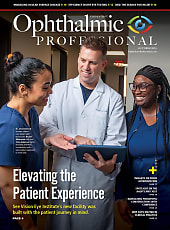Proper documentation is essential for compliance with payor requirements. The International Classification of Diseases, Tenth Revision, Clinical Modification (ICD-10-CM) is a standardized system used to code diseases and morbidity data. Healthcare providers use ICD-10-CM codes when diagnosing patients.1 Use of the correct ICD-10-CM diagnosis code is vital when coding for exudative age-related macular degeneration (wet AMD). Here are some guidelines to help avoid common pitfalls.
Q. What diagnosis codes are used for wet AMD?
A. The ICD-10-CM codes for wet AMD are based on laterality and provide the first 6 characters of the code:
H35.321: Exudative age-related macular degeneration, right eye.
H35.322: Exudative age-related macular degeneration, left eye.
H35.323: Exudative age-related macular degeneration, bilateral.
H35.329: Exudative age-related macular degeneration, unspecified eye.
A seventh digit is added to indicate the stage of the disease process. Zero is “stage unspecified,” 1 is “with active choroidal neovascularization,”
2 is “with inactive choroidal neovascularization with involuted or regressed neovascularization,” and 3 is “with inactive scar.”
Coding to the highest specificity is required, so using an unspecified eye diagnosis code would be inappropriate, as would leaving out the relevant seventh digit.
Q. What if wet AMD affects both eyes, but at different disease stages?
A. In that case, each eye should be coded with its specific condition and stage. For example:
H35.3211 (right eye with active choroidal neovascularization)
H35.3223 (left eye with inactive scar)
If the patient had wet AMD in both eyes, and both were at the same stage, the coder would use the bilateral code (H35.323) with the appropriate stage seventh digit.
Q. What documentation is needed to justify treatments for wet AMD?
A. Documentation should include a confirmed diagnosis with supporting exam findings. The medical record documentation should include notes detailing the disease stage and response to treatment for each eye. Diagnostic imaging (eg, retinal OCT, OCT-A, or other diagnostic test that provides essential information) should be included, and the medical necessity for each injection or procedure must be specified.
Q. What are the common reasons for claim denials in wet AMD billing?
A. Common reasons for denial include missing or incorrect diagnosis codes, incorrect modifiers for laterality, a lack of prior authorization for Medicare Advantage (Medicare Part C) or commercial payors, or incomplete documentation of medical necessity. (Remember, the chart documentation should indicate the “why?”)
Q. What are common reasons for claim denial when changing drugs?
A. Common reasons for claim denial include:
Conflicting information in the chart documentation. For example, the test results indicate improvement, but the Impression and Plan state the patient is doing worse.
Lack of documentation indicating the current drug is not working as expected or there is a suboptimal response to the current drug.
Failure to follow the “try-and-fail” steps the payor may require. More payors are stating what they consider as a “failure” for the current drug treatment.
Q: Is prior authorization required for anti-VEGF injections?
A. Yes, many payors require prior authorization. Check with the specific payor to ensure coverage of the drug and diagnosis code(s). Ensure the prior authorization request submitted includes the appropriate diagnosis code supported in the chart documentation. Remember, the payor may provide prior authorization, but the fine print indicates it is not a guarantee for payment.
By understanding these questions and answers, physicians, techs, scribes, and billing professionals can enhance accuracy and reduce denials for wet AMD-related services. RP
Reference
1. Centers for Medicare & Medicaid Services. ICD-10. Updated January 17, 2025. Accessed February 3, 2025. https://www.cms.gov/medicare/coding-billing/icd-10-codes









